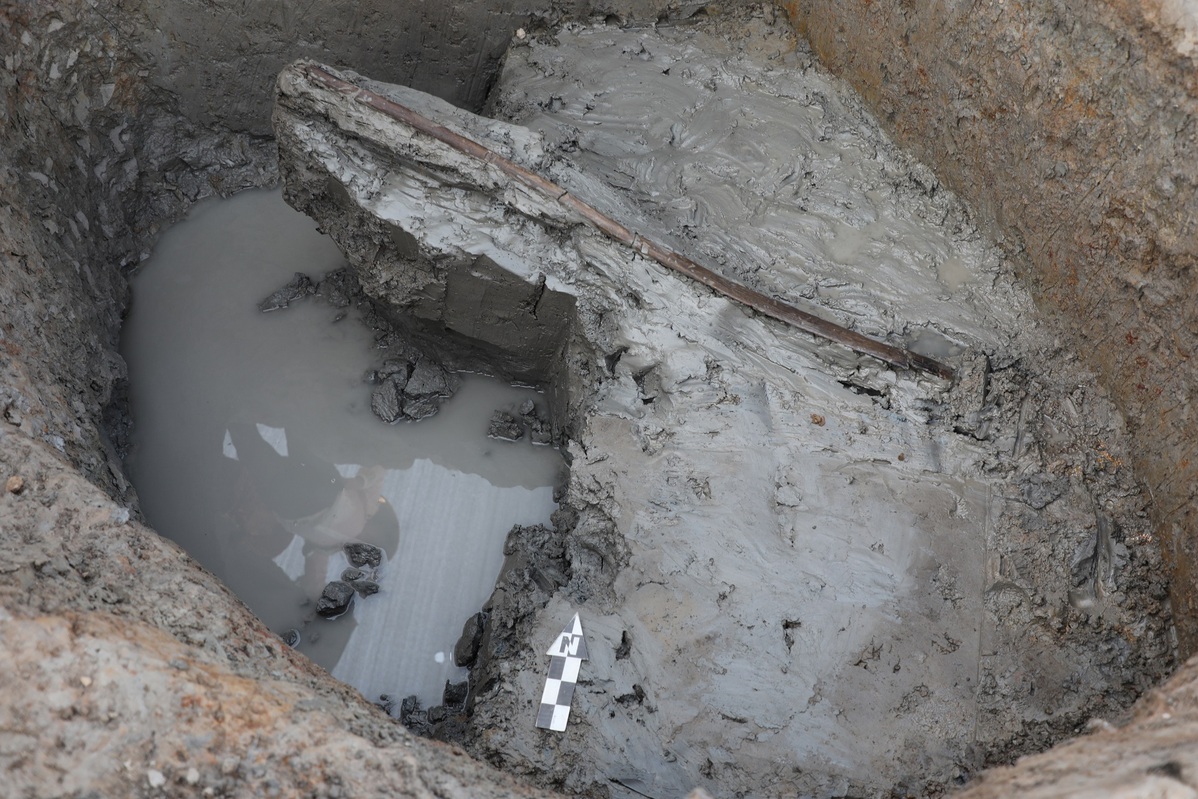Shaoxing archaeological discoveries unveil the mastery of the Yue state

Wooden oars unearthed from the relic site of Dahutou in Yuecheng district of Shaoxing, East China's Zhejiang Province. [Photo by You Xiaolei/For chinadaily.com.cn]
The archaeological discoveries in the relic sites of Dahutou and Nanshan in Yuecheng district, Shaoxing, unveiled people's daily life and production activities in the Eastern Zhou Dynasty (770-256 BC), which is especially meaningful for the study of the ancient capital and the culture of the Yue state.
"Two wooden oars were unearthed from the relic site of Dahutou, which is the first wooden oar from the Eastern Zhou Dynasty unearthed in Shaoxing, providing materials for the study of its water town," You Xiaolei, director of the Shang and Zhou Dynasties Archaeological Office of the Zhejiang Provincial Institute of Cultural Relics and Archeology, told China Daily.
"In addition, we also found a porcelain musical instrument set, comprising three cylinder-like percussion instruments and six others resembling ancient chime bells," said You.
You added that this kind of musical instrument was generally found in the tombs of nobles in the Yue state. "This is the first time that a group of musical instruments has been unearthed in a site of the Yue state, providing precious unearthed materials for the study of the ritual system of the Yue state."
Since 2021, archaeologists also discovered a large number of plants during the Spring and Autumn Period and the Warring States Period at the site. These include rice, rice husks and rice spikelet. It is estimated that rice was the main food of the residents at that time.
In addition, archaeologists also discovered vegetable seeds such as gourds, gray vegetables and peppercorns, as well as seeds of fruits such as plum stones, plum stones, peach stones, persimmons, melons, grapes and kiwifruit.
"The excavation at the relic site of Dahutou reveals the rural settlements of the Yue culture and unveils the details of the lives of our ancients more than 2,000 years ago, promoting the research progress of the Yue culture," You told China Daily.
In another site, the relic site of Nanshan, archaeologists found a large number of primitive porcelain; stone tools; potteries; bronze tools and weapons; plant remains such as carbonized rice, peaches, plums and grapes; and animal remains like cattle, pigs, horses, fish and tuna.
It was unexpected to find the remains of deep-sea fish such as tuna at this site, said Xu Xinmin, a researcher at the Zhejiang Provincial Institute of Cultural Relics and Archeology.
Xu was also surprised by the unearthed remnant of a bronze dagger-axe with a word in bird-and-insect script on both sides. The word means "Yue".
"The expert said that the remnant of the bronze dagger-axe has a history of about 2,000 years. The remnant is preserved safely without much damage in nature, we can imagine how advanced the handicraft industry and cultural level of the Yue state was at that time," said Xu.
"The relic site of Nanshan is located at the center area of the Yue state. It is likely to have a close connection with its capital. The findings are a breakthrough archaeological discovery of the study of the state's society, economy and culture," Xu told China Daily.

